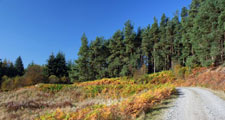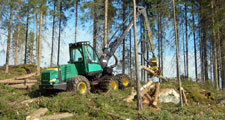Managing Plantations
The Need for Management
Many of the county’s woodlands are plantations. They vary from large forests and plantations established for timber production in the 19th and 20th centuries to smaller mixed or broadleaved woodlands planted for shelter or farm timber, or as part of designed parklands and estates. Older planted woods have in some cases developed characteristics of semi-natural woodland. Some plantations are managed by selective felling under shelterwood or group felling systems. Others are managed under rotational clear cutting regimes.
While many plantations sit well in the landscape and are an integral part of its character, there are those which were planted with little regard to landscape character, biodiversity, water quality or archaeology. Management, harvesting and restocking operations bring opportunities to restructure plantations to improve their fit with the surrounding landscape, enhance their amenity and wildlife value, and reduce their impact on archaeological features and natural resources.
Published Guidance
The Forestry Commission has published guidance on managing, felling and restocking planted woodlands as part of The UK Forestry Standard (Standard Notes 1,4 and 6) together with a range of Management Handbooks on individual topics. Some of these can be downloaded from the Forestry Commission website.
General Principles
- Plan ahead. Long term felling and restocking plans can help integrate environmental objectives with silvicultural and financial considerations. In large woods, re-structuring may need to be undertaken over more than one rotation.
- Get to know the wood. Identify and map any areas of native woodland and notable features like outcrops and watercourses, specimen or veteran trees, native ground flora and cultural features. Analyse the age and species structure of the wood and look for opportunities to increase diversity when felling and restocking.
- Find out as much as you can about the wood’s history and ecology. The County Ecologistand Durham Wildlife Trust may have information on its flora and fauna, and the County Archaeologist and local history societies on its historical interest or archaeological features within it.
- Find out if there are any landscape designations – SSSI, County Wildlife Sites, Scheduled Ancient Monuments, Conservation Area, Tree Preservation Orders etc – that might affect how the wood needs to be managed.
- Find out about any protected species that may be affected by your proposals (particularly bats and red squirrel). Contact specialist groups if necessary.
- Take advice. The Forestry Commission provide advice, grants and useful publications on managing native woods. They can also recommend specialists for carrying out more detailed assessments. A Woodland Assessment Grant may be available to help you undertake assessments of ecological, landscape, historical and cultural factors and for community involvement.
- Where possible introduce group felling or continuous cover systems to maintain maturity of habitat and continuity in the landscape. Where this is not possible for the whole woodland, identify any areas that can be managed under continuous cover as part of a network of permanent woodland, open ground, watercourses and semi-natural habitats.
- Approach restocking as if designing from first principles. Identify features in need of improvement and avoid repeating existing design problems.
- Maintain diversity of habitats within and around the wood and particularly features like stands of native species, open glades and wetlands. Design in new areas of open ground related to wetlands, watercourses, rides, outcrops and cultural features.
- Increase structural diversity by felling parts of even-aged woods at different times. Avoid felling larger areas that required. Design felling compartments to reflect the scale and form of the topography.
- Consider restocking wholly or partly with native broadleaves and particularly on sites close to existing ancient woodland or other valued habitats, in sensitive landscapes, or where there is potential for growing marketable hardwoods.
- Consider not restocking at all when planting has taken place on areas of sensitive habitat or archaeological interest, or in situations where woodland no longer seems appropriate for environmental or silvicultural reasons.
- When restocking with softwoods, increase the proportion of native broadleaved trees and shrubs. Locate them strategically along margins, rides, crop edges, glades and watercourses.
- Adjust the edge structure when restocking to improve its appearance in the landscape and its nature conservation value. Irregular woodland and crop edges containing permanent broadleaved trees and shrubs can improve biodiversity and crop stability.
- When planting broadleaves for timber or environmental reasons, use species characteristic of the native woodland types suited to the site where possible. Use plant material of local origin or from the nearest FC Seed Zone unless particular timber provenances are essential.
- Take care when planting mixtures – particularly of evergreen and deciduous species – to avoid obtrusive geometric patterns in views from the wider landscape.
- Retain old and veteran trees, and dying or diseased trees where it is safe to do so, along with standing and fallen deadwood. Give veteran trees space – don’t restock too close to them.
- Use low impact felling and extraction techniques in areas of archaeological or ecological sensitivity.
- Remove trees carefully from archaeological features and keep them clear of regeneration.
- Manage rides, road edges and open spaces sympathetically where they have nature conservation value.
- Identify social & recreational impacts. Where appropriate hold discussions with the local community.
- Look to areas surrounding the woodland for opportunities to extend it, or manage them sensitively to compliment the woodland habitat – for example by creating conservation headlands around arable fields, or restoring hedgerows to improve connectivity.



